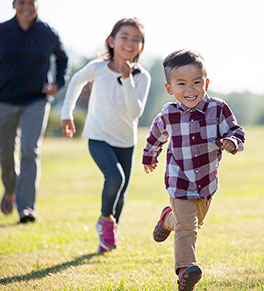Kids, exercise and COVID-19

Soccer clubs, pickup basketball games, physical education classes and dance studios — these and so many other venues for children and teenagers to get exercise are now off limits to prevent the spread of the novel coronavirus.
Yet physical activity is still important for their health, and young children have loads of energy they are itching to release.
Fortunately, even without organized activities, parents can do plenty to get their housebound children moving — and have fun doing it, says Dr. Christopher Kroner, a UCI Health family physician and specialist in sports medicine.
Preschool and early elementary ages
Very young children are naturally active, says Kroner, who has two children ages 3 and 5. When they’re close in age, it’s often enough just to clear a space and let them chase each other around.
Let them use a very soft ball — a plush ball might be a good choice indoors — to play a simplified soccer game without breaking household items things (but remove anything delicate, anyway).
If young children don’t have a sibling near their age to play with, make up some simple games to play with them, such as Simon Says, making sure to incorporate some active moves such as stretches and calisthenics they can imitate.
Not enough space in the house to clear for running around? Yoga builds real strength in young muscles and is great for developing gross motor skills, Kroner says. He particularly likes Youtube’s Cosmic Kids Yoga videos, which are geared to very young children and feature visual effects and storytelling.
Many kids also love to jump so a small trampoline with a handlebar lets kids develop their motor skills safely without destroying the living room couch. Just make sure there is plenty of space around it for safety.
If you have a good-sized backyard, consider sprinting competitions or playing with a kickball or soccer ball to help children build strength and stamina.
Older children and teens
Older children generally crave more space to play. Remember, it’s still considered healthy to go outdoors for a walk or bike ride, Kroner says. In fact, everyone in the family regardless of age would probably enjoy such outings.
But in each place, it’s still necessary to keep a safe distance — six feet — between your family and others. And be sure to wear a cloth face covering. Play as a family, not as a community at this point. You could kick or throw a ball or run, or use a basketball court as long as no one else is on it.
Just keep everyone from touching playground equipment, which has been touched by many hands. Avoiding holding railings or touching other surfaces as well. Bring hand sanitizer in case you do need to touch something or one of the kids doesn’t pay perfect attention to the rules.
Teens might show more interest in playing video games over the internet with friends than in exercise, Kroner says. That’s OK. It’s a stressful time and this keeps them connected with friends. Let them have a couple of hours of device time before recommending a family get-up-and-move outing.
If you have exercise equipment at home such as a treadmill or cycle, teenagers might enjoy using them. But remember that exercise equipment is not safe for pre-adolescents.
The idea, Kroner says, is to make sure the family isn’t sitting all day, and is seeing activity as a positive, joyous part of their day.
Related stories
- Sleep, immunity and COVID ›
- Coping with the stress of COVID-19 ›
- Disinfecting your home to kill viruses ›
- When to see a doctor about COVID ›
- Caring for COVID at home ›




